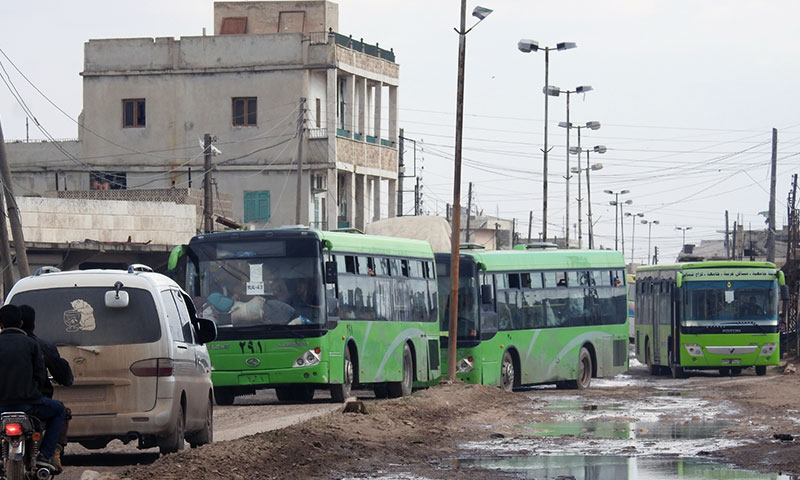The delayed entry of the displaced people’s convoys from rural Homs and southern Damascus to northern Aleppo has inspired a wide range of local reactions, with fingers of blame all directed at Turkey, being responsible for the area, for preventing Syrians from entering a Syrian territory.
Four convoys, transporting more than 5 thousand people, have waited for long hours at the Abu al-Zendin border crossing, near the city of al-Bab, under bad weather conditions.
The first convoy exited the northern countryside of Homs, carrying 3391 people, distributed to 66 convoys, of whom seven are urgent medical cases. This convoy was the first under the evacuation agreement that Russia and the Syrian regime have imposed on rural Homs. The majority of this convoy’s people have entered unofficially, for in the city of al-Baba many families from Homs live, who thus received the newly displaced people.
About 500 people from the convoy stayed at the crossing and were not allowed entry, after which a number of convoys were suck in the same place, including the second convoy from rural Homs, carrying 2803, in addition to the fifth, sixth and part of the seventh convoy of southern Damascus’ displaced people.
The Syrian Interim Government Interferes
After five days of waiting, which witnessed a number of demonstrations and protests by citizens from the city of al-Bab, demanding that Turkey allow the displaced people’s entrance, the convoys were allowed to move in, for the head of the Syrian Interim Government, Jawad Abu Hatab, has contacted the Turkish side.
In the northern countryside, places to accommodate the people were prepared, as the Interim Government’s Head’s spokesperson, Yasser al-Haji, has told Enab Baladi.
As for the southern Damascus convoys, 2391 people entered the area, distributed as follows: The fifth convoy included 1369 people, the sixth carried 655 and part of the seventh transported 367 people, in addition to the remaining people of the first northern Homs convoy, which carried 500 displaced people.
Giving Up the Weaponry was Behind the Banned Entry
In the past a few days, several concerned entities raised a number of questions about the reasons behind Turkey’s prevention of the displaced people’s entry to rural Aleppo.
In a former interview, Jamal Osman, told Enab Baladi that the convoys followed one another, and that when the first convoy from the northern countryside of Homs arrived at Abu Abu al-Zendin, there was no coordination, pointing out that the people’s number was massive and that no residents existed nor the housing centers were prepared, in addition to some of the fighters’ refusal to give up their weaponry to the Turkish army, stressing that the organizations were not prohibited from helping the displaced people at the crossing.
Firas Radwan Oğlu, a writer and political analyst, has attributed convoy’s banned entry to two reasons: the first is the weak coordination between Turkey and the displaced fighters on the one hand and between Turkey and Russia on the other hand, proposing the entry of former convoys as an evidence, wondering whether Turkey possesses the files of all these fighters as to know the people moving in/out of the area.
The second reason lies in the attempt to overcome the problems that faced the former convoys, in relation to disarmament, which is considered highly threatening for the area is under the military aegis of Turkey, which holds the area’s responsibility in front of the international community, for any sort of security tension in rural Aleppo will affect Turkey, similar to what happened in the city of Afrin, when some of the Kurdish people’s houses were appropriated and due to the media and human rights campaign that accompanied these incidents.
Oğlu stressed the fact that time has disappointed Turkey for the Turkish President Recep Tayyip Erdoğan has repeatedly pointed out to the reconstruction of rural Aleppo to house the displaced people and help the emigrants return to their homes; however, the sudden displacement of astern Qalamun, the northern countryside of Homs and southern Damascus has surprised all of us.

